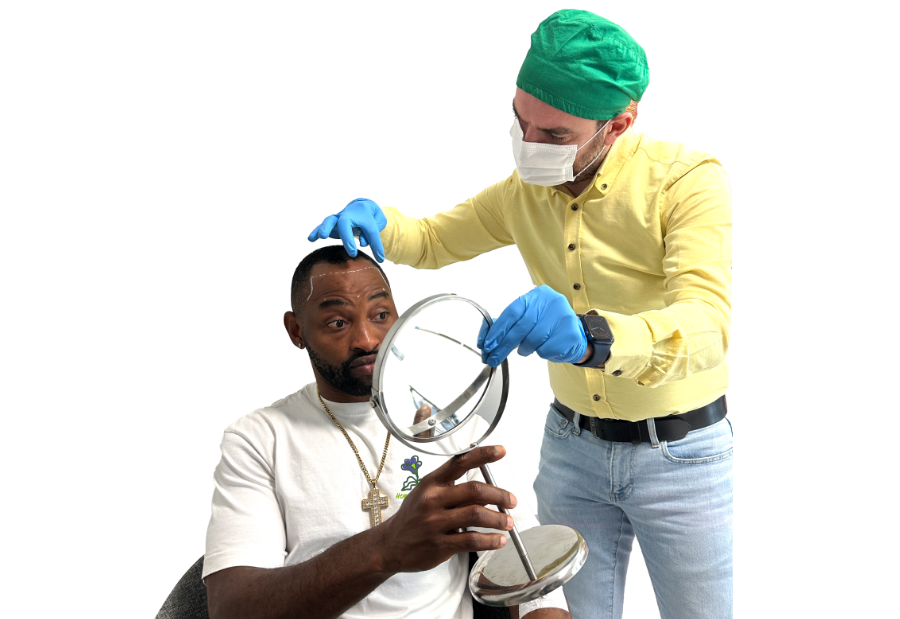Get 25% OFF Hair Transplant Packages This New Year — Book Today!
Timeline of Recovery After a 2000 Grafts Hair Transplant in Turkey

Introduction: What to Expect After a 2000 Grafts Hair Transplant
Going through a 2000 grafts hair transplant is an exciting step, but recovery is where the real transformation happens. If you’ve chosen to have your hair transplant in Turkey, you’ll already know that the clinics there provide detailed guidance.
Still, it helps to understand the timeline for yourself. Knowing what happens day by day and month by month can take away much of the worry. This guide gives you a clear picture of what’s normal, what’s not, and when you’ll begin seeing the new hairline you’ve been waiting for.
Why 2000 Grafts? What It Means and Covers
What Are Hair Grafts?
A graft is a small unit containing one to four follicles. When you read “2000 grafts”, it means that about two thousand of these units have been moved from donor areas to thinning areas. Depending on the density, that can mean several thousand hairs in total.
Is 2000 Grafts a Large Session?
It’s usually considered medium-sized. For someone at Norwood stage 3 or 4 hair loss, 2000 grafts can rebuild a hairline or cover a thinning crown without needing multiple days of surgery. If someone requires larger coverage, a 3000 grafts hair transplant or more might be suggested.
If you’re curious about the recovery timeline, check out our detailed guide on hair transplant 6 months vs 1 year to see what results you can expect.
Why Patients Choose Turkey for Hair Transplants
People don’t just travel for the lower prices. Turkey has earned a strong reputation in this field. Clinics are very experienced; surgeons frequently travel internationally as a training aspect; packages include aftercare.
Many visitors are also comforted that the medical tourism nature of the services, airport pickup, translator and accommodation has eliminated stress.
Watch this YouTube video on 3500 Grafts at Grace Touch Clinic to gain deeper insights and see practical results in action.
Hair Transplant Recovery Timeline: Day-by-Day and Week-by-Week
Day 0: Surgery Day
Expect to be at the clinic at least six to eight hours. Local anesthesia is used with both surgeries; you will be awake but relaxed. A bandage is applied at the end. Some numbness and swelling are common, but they usually settle quickly.
Day 1 – 3: Initial Healing Begins
These first days are all about rest. There may be redness and mild pain around the donor area and receiving areas. Tiny scabs will form where the follicles were placed. Avoid touching your scalp or washing it. Clinics often prescribe antibiotics or anti-inflammatories to reduce discomfort.
Day 4 – 7: Scab Formation and Reduction
By now, scabs begin to harden and dry. Your surgeon will show you how to gently wash your scalp. Swelling starts to ease off. The hairline still looks delicate, so this stage is mostly about patience.
Week 2: Shedding Phase Begins
This part can feel worrying, but it’s completely normal. The transplanted hairs begin to fall out in a process called “shock loss.” The follicles remain under the skin, safe and intact.
Week 3 – 4: Return to Normal Activities
The scalp starts to look calmer. You can usually go back to the gym or resume light sports, though heavy lifting might need more time. Normal hair care routines can resume once you follow your clinic’s protocols.
Month 2 – 3: Dormant Phase
The moment may feel a little quiet. There isn’t very much you see to grow, and that is expected. Underneath, the transplanted hair follicles are trying to establish themselves to sprout.
Month 4 – 6: Initial Hair Growth Appears
You will start noticing the baby hairs. At first they may look thin, soft, or wiry. Don’t judge the final result just yet. This is only the start.
Month 6 – 9: Noticeable Hair Density Increase
The hair will start to thicken and gain length and will feel more natural. Around this time, you might want to trim or style it for the first time. Many people begin to feel more confident as the hairline takes shape.
Month 10 – 12: Final Results Become Visible
Most patients report 80–90 % of the transplanted growth has grown in by this moment. The coverage is blending with the existing hair; the texture feels synonymous. This is the point where 2000 hair graft before and after photos show just how much progress has been made.
Post-Op Care Tips to Speed Up Recovery
Follow Washing Instructions Strictly
Don’t rush washing in the first days. Use the products your clinic recommends and avoid scratching.
Avoid Direct Sun Exposure
The sun is likely to irritate your healing skin and slow the recovery. Hats or shade are your best friends in the first weeks.
Don’t Smoke or Drink for 2 Weeks
Both alcohol and smoking affect circulation and healing. Giving them up during recovery helps the grafts settle.
Use Recommended Shampoos and Serums
Mild, medical shampoos protect the new follicles. Some clinics also suggest growth serums after the first month.
Sleep with Head Elevated for 7–10 Days
Keeping your head raised reduces swelling. Two or three pillows usually do the job.
For a smooth recovery and long-lasting results, check out our detailed post-transplant hair care tips that guide you through every stage of healing.
Potential Side Effects & When to Contact Your Clinic
A general discomfort is a part of the experience with any surgery, but if you experience any of these symptoms, it is important to contact your surgeon:
- Swelling or redness lasts longer than 10 days
- Severe itching or pus-filled bumps
- Signs of unusual bleeding or thick crusting
You can reach out any time as most Turkish clinics provide 24/7 post-op support.
Results Comparison: What 2000 Grafts Typically Look Like
- Before and After: A 2000 graft hair transplant cost is often worth it when you see how much a hairline or crown can change in a year.
- Hairline Reconstruction: With 2000 grafts, surgeons can rebuild the frontal line to look sharp yet natural.
- Crown Coverage: For thinning at the back, 2000 hair grafts usually create visible density without over-harvesting the donor area.
FAQs: Recovery After 2000 Grafts Hair Transplant
Q1. When can I go back to work?
Most people return within a week. If your job is physical, you might need a little longer.
Q2. Is the shock loss permanent?
No. The shedding is temporary, and new hairs begin to appear around month three or four.
Q3. Will people notice I had a transplant?
In the first week, redness and scabs are visible. After that, most people won’t notice unless they know what to look for.
Q4. Can I wear a cap after surgery?
Yes, but only after the first 7–10 days. Choose a cap that’s loose and doesn’t rub against the grafts.
Conclusion: Patience Pays Off
A 2000-graft hair transplant recovery develops over one year, and throughout this journey, you see each stage bring you closer to a full head of hair.
As long as you follow the aftercare rules, take care of your scalp and are patient with yourself, you will be amazed at how much of a difference it can make. The 2000 hair graft before and after photos clearly illustrate the transformation.
And if you’re weighing up options, ask your surgeon how much it costs for hair transplant procedures like this, compare clinics, and choose a team that supports you every step of the way. With time and care, those 2000 hair grafts will give you natural coverage and long-lasting confidence.

